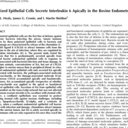First Report of Bacterial Leaf Spot on Snow Lotus Caused by Pseudomonas syringae in China.
키워드
요약
Snow lotus (Saussurea involucrata (Kar. & Kir.) Sch. Bip.) is an economically important medicinal herb increasingly grown in China in recent years. During the summer and autumn of 2005, 2006, and 2007, a necrosis of unknown etiology was observed on leaves in commercial production areas in Xinjiang Province of China. Disease incidence was approximately 40 to 50% of the plants during the 2005 and 2007 growing seasons. Initial symptoms consisted of pronounced water-soaked, dark brown-to-black spots that were 1 to 2 mm in diameter on young, expanding leaves. Later, some leaf spots on older leaves enlarged and coalesced, causing leaf desiccation. Leaf samples were collected in 2005, 2006, and 2007 from the affected hosts. Bacterial streaming was evident from these samples, and 28 strains were isolated on nutrient agar or King's medium B (KMB). All strains were gram negative and fluoresced bluegreen under UV light after 48 h of growth at 28°C on KMB. On the basis of LOPAT tests, the strains were identified as Pseudomonas syringae (1). The identity of two strains was confirmed by sequencing the 16S rDNA gene, which revealed 98% similarity to P. syringae strains in NCBI (Accession Nos. FJ001817 and FJ001818 for XJSNL 111 and 107, respectively). Infiltration of tobacco leaves with bacterial suspensions resulted in typical hypersensitivity reactions within 24 h. Pathogenicity of the strains was confirmed by spray inoculating five snow lotus leaves of a six-leaf stage plant with 108 CFU ml-1 bacterial suspensions in sterile water and five plants sprayed with sterile distilled water served as controls. Inoculated and sterile water-sprayed controls were maintained in the growth chamber with 90% relative humidity for 15 days at 15 ± 2°C. Symptoms similar to the original symptoms were observed on inoculated plants after 2 weeks. No symptoms developed on controls. Bacteria reisolated from inoculated plants were identified as strains of P. syringae. Isolates were deposited at the Key Laboratory for Oasis Crop Disease Prevention and Cure, Shihezi University. Rust caused by Puccinia carthami and leaf spot disease caused by Alternaria carthami of snow lotus have been reported (2,3). To our knowledge, this is the first report of P. syringae as the cause of bacterial leaf spot on snow lotus in China. References: (1) A. Braun-Kiewnick and D. C. Sands. Pseudomonas. Page 84 in: Laboratory Guide for the Identification of Plant Pathogenic Bacteria. 3rd ed. N. W. Schaad et al., eds. The American Phytopathological Society, St. Paul, MN, 2001. (2) S. Zhao et al. Plant Dis. 91:772, 2007. (3) S. Zhao et al. Plant Dis. 92:318, 2008.


